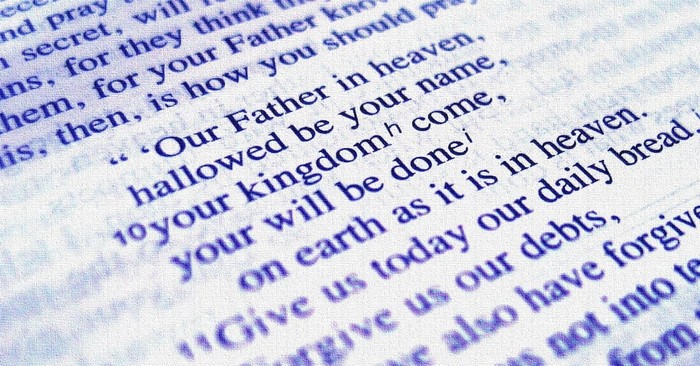
“This, then, is how you should pray: ‘Our Father in heaven, hallowed be your name, your kingdom come, your will be done, on earth as it is in heaven. Give us today our daily bread. And forgive us our debts, as we also have forgiven our debtors. And lead us not into temptation, but deliver us from the evil one.’”
Where is the Lord’s Prayer in the Bible?
The Lord’s Prayer is in Matthew 6:9-15 and Luke 11:2-4. In the gospel of Matthew, it is a part of a sermon Jesus preached called the Sermon on the Mount. In this sermon, he addressed his disciples and gave them practical instructions on how to live. Jesus’ purpose for giving instructions on prayer was to correct the Pharisees’ practice of praying corporately to impress people and to correct the Gentiles’ practice of praying long repetitive prayers.
I believe this is many people’s experience with the Lord’s Prayer: they memorized it, not knowing what it means and merely recite it, instead of truly praying it. However, the Lord’s Prayer is more practical than we give it credit. Even though I don’t say the Lord’s Prayer often, it gives me a framework for praying that keeps me focused and intentional.
Years ago when I was in the high school marching band, we said the Lord’s Prayer out loud as a group before each football game. However, it felt more like reciting a poem than praying. It was years later that I learned the purpose of the Lord’s Prayer and the prayer’s true meaning. We should use it as a model for how to pray. I use its framework, alongside the A.C.T.S prayer sequence, every day as I pray by myself.
The A.C.T.S. Method of Prayer
You may be familiar with the prayer acronym A.C.T.S, that stands for Adoration, Confession, Thanksgiving, and Supplication. For the past few years, I have prayed using the A.C.T.S. method. What surprised me was that it has the same elements the Lord’s Prayer has, except for the explicit prayer of thanksgiving.
I want to emphasize that this is only one framework for prayer and not the only way to pray. More than anything, Jesus just wants us to come to him. All of our words to him he accepts as our movement toward him. They are lovely for him to hear.
Here is how I use A.C.T.S to pray based on the Lord’s Prayer:
Adoration Prayer
Adoration simply means adoring God, giving him his rightful credit, and acknowledging his attributes. “Our Father in heaven, hallowed be your name” (Matthew 6:9). The Lord’s Prayer starts with adoration. Here we use the words “Father” and “hallowed” to show who God is to us and what his name means to us.
“Father” is the most endearing identity of God for us. It wasn’t until my own children were born that I fully wrapped my mind around this love. At the same time, God’s love is infinitely more complete than mine for my earthly children. But having our own children gives us a glimpse of God’s love for us.
“Hallowed be Your Name” - What Does Hallowed Mean in the Lord’s Prayer?
The word “hallowed” intimidates us. It’s one of those Bible words that convinces us the Bible is too hard to understand. However, hallowed simply means holy. When we pray “hallowed by your name,” we’re praying “holy is your name.” We’re recognizing God’s holiness.
Of course, we can pray both Father and hallowed, but more than praying these specific words, the Lord’s Prayer begins with the model of telling God how wonderful he is to us. During this part of the prayer, we pray the attributes of God. There are too many attributes of God to list here, but some are sovereign, righteous, our healer, our comforter, just, love, merciful, and faithful. We can simply start our prayer like this:
“Heavenly Father, I start by telling you how much I love you. You are…” and then name his attributes back to him.
Confession Prayer
During confession, we admit our sins to God and ask him to forgive us - “and forgive us our debts, as we also have forgiven our debtors” (Matthew 6:12).
A prayer I pray often for my children is that they will know that they are sinners. It seems counterintuitive from a worldly perspective. We think that admitting you’re a sinner will damage your self-esteem or sense of self-worth. However, the opposite is true. Until we are able to admit our sins, we’ll never be able to experience freedom in Christ and true self-esteem.
Confession during prayer is our opportunity to admit our sins to God and to find the weight of our sin lifted. “If we confess our sins, he is faithful and just and will forgive us our sins and purify us from all unrighteousness” (1 John 1:19).
Thanksgiving Prayer
It’s interesting that in the Lord’s Prayer, Jesus does not explicitly instruct us to pray thanksgiving (to pray with thankfulness). I don’t think we know for sure the reason for that. However, despite that omission, other parts of scripture make it clear that Jesus wants us to be thankful and express our thankfulness to God during prayer.
In 1 Thessalonians 5:17-18, Paul instructs us to “pray without ceasing, give thanks in all circumstances; for this is the will of God in Christ Jesus for you.” Jesus also thanked God many times throughout Scripture. He offered a prayer of thankfulness before meals like in Matthew 14:16-21 and Matthew 15:35-38. He gave thanks at the Last Supper in Matthew 26:26-27. Jesus thanked God for the miracle of bringing Lazarus back to life in John 11:41. And He thanked God in Matthew 11:25 for revealing the secrets of the kingdom to those who were deemed less-than.
Because the Lord’s Prayer was meant more as a model for prayer and not a prayer to necessarily be recited, Jesus may have not included thanksgiving under the assumption that our hearts are in a perpetual state of thankfulness because of what God has done for us. We pray out of our thankfulness to Him. Regardless, in the A.C.T.S acronym thanksgiving is included and appropriately so.
Supplication Prayer
Supplication is a big word, which simply means asking God for what we need and want. For most of us, this is the meat of our prayers and the part we often jump to first. That is why I like to use the A.C.T.S method to structure my prayers. When I use A.C.T.S, I set my heart first on who God is and what He has already done for me before I make further requests. With that said, there are many times that I am desperate and my only prayer is “Jesus, help me.” Again, there is no right way to pray.
“Your Kingdom Come” - Pray for Jesus’ Return and Rule
In the Lord’s Prayer, Jesus gives us several petitions to ask. First, we ask that God’s kingdom come. In one sense, God’s kingdom has already come with the birth, death, and resurrection of Jesus. However, this is asking God to allow the fullness of his kingdom to come - for Jesus to come back.
“Your Will be Done on Earth as it is in Heaven” – Pray for God’s Will to be Done
Then we ask “your will be done, on earth as it is in heaven” (v. 10). This is our acknowledgment of God’s sovereignty. He is in control, and he knows what is best based on his knowledge of the past, present, and future and based on his plans for eternity. It is like we are holding the game ball and asking God to do all these things, but then we pass the ball to him and say, “Now do whatever you want.” The greatest example of this in the Bible is when Jesus was in the Garden of Gethsemane and prayed this exact prayer to God before his crucifixion (Matthew 26:39).
“Give Us This Day Our Daily Bread” - Pray for God to Meet Our Daily Needs
Next, Jesus models asking God to “Give us this day our daily bread” (v. 11). What’s fascinating about this request is the way it’s worded. It doesn’t read, “Give us food today,” or “Give us this day our bread.” Instead, Jesus uses the words “our daily bread.” This is a request for anything we might need that day, food and otherwise, and the emphasis is on daily. We’re not to get caught up in God providing for us in the days to come, although it’s okay to ask for that, too. But instead, this verse anchors our hearts back to the present, the here and now, and acknowledges that right now we only have today. So we’re asking God to give us whatever we might need in this day - food, provision, strength, emotion stability, health, etc.
“Lead Us Not into Temptation but Deliver Us from Evil” - Pray for Protection and Deliverance
Verse 13 has to do with our vulnerability to sin and our broken, sinful nature - “And lead us not into temptation, but deliver us from evil.” Here we ask for protection when we’re tempted and deliverance from temptation. We’re asking God to build our spiritual muscles so that we can experience the abundant life He’s promised us.
Throughout our time of supplication, we, of course, pray everything we need and want for ourselves, others, and this world. However, we do it under the umbrella of God’s kingdom purposes - that Jesus is coming again, God’s sovereignty - that His will is perfect, God’s protection - that He is the only one who can protect us from temptation, and God’s deliverance - that He’s the only one who can deliver us from the grip of strongholds in our lives.
When we see the Lord’s Prayer like this and make it practical by using A.C.T.S to help us, it becomes a valuable and unused resource that can strengthen our prayer lives and draw us closer to God.









